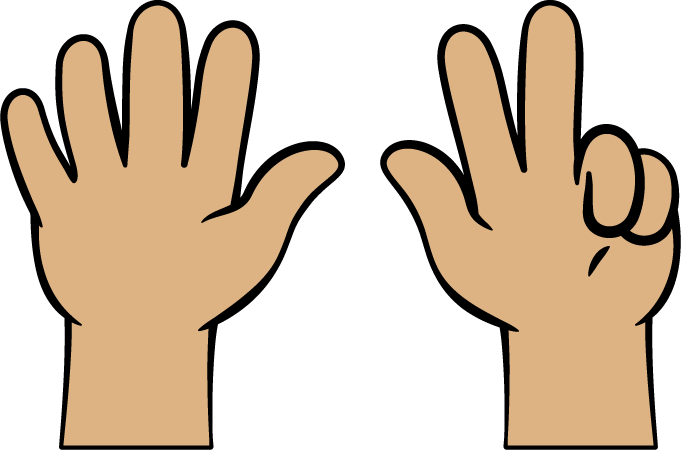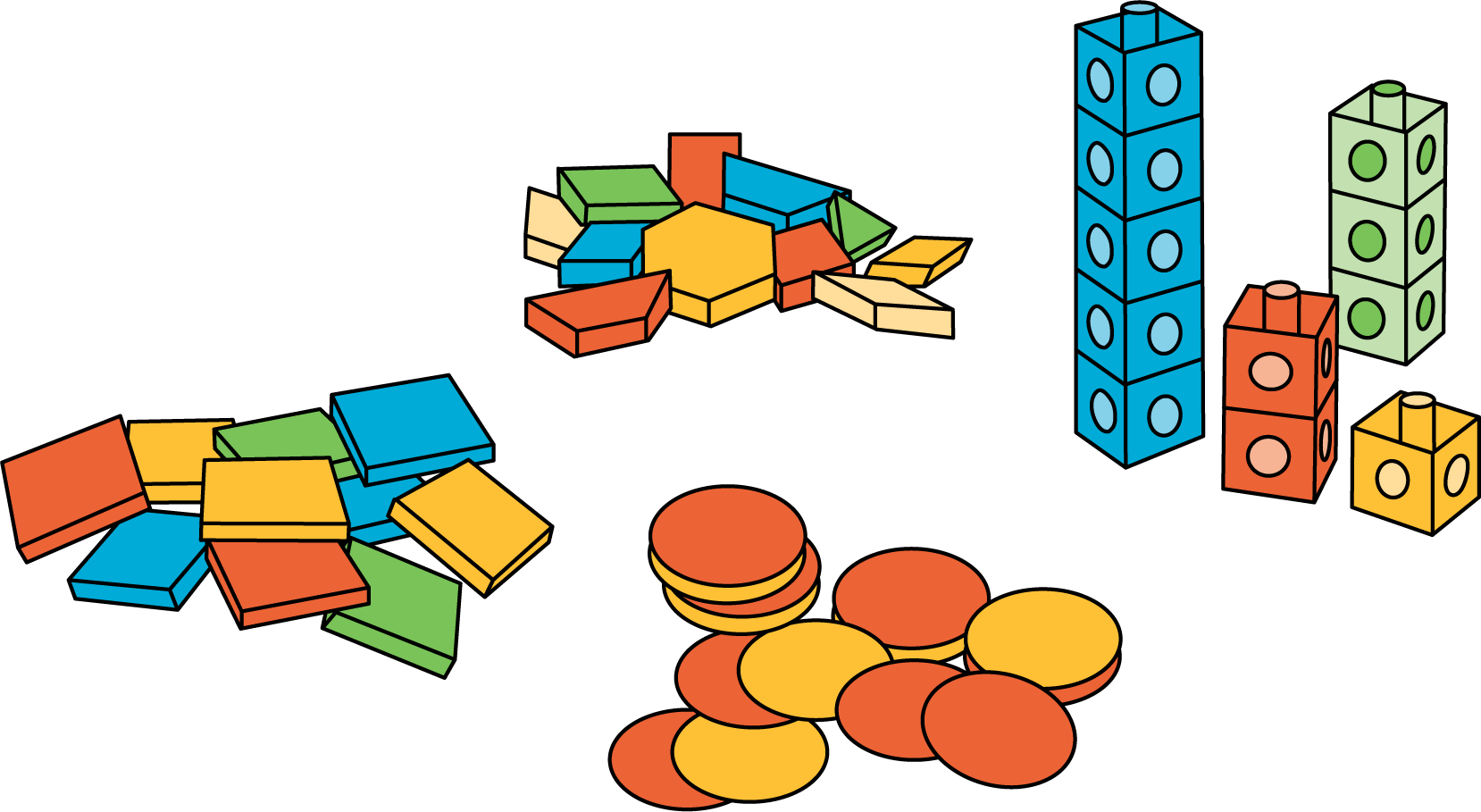Lesson 12
Compare Addition and Subtraction Story Problems
Warm-up: Choral Count: Count to 40 (10 minutes)
Narrative
The purpose of this warm-up is for students to practice saying the verbal count sequence to 40. Students also see the numbers written as they say each number.
Launch
- “Let’s count to 40.”
Activity
- Count to 40 together.
- Record as students count.
- Count to 40 1–2 times. Point to the numbers as students count.
Student Response
For access, consult one of our IM Certified Partners.
Activity Synthesis
- “What number comes next when I count? 4, 5, 6, 7...”
- “What number comes next when I count? 12, 13, 14, 15...”
- “What number comes next when I count? 16, 17, 18, 19...”
Activity 1: Ducks in the Pond (10 minutes)
Narrative
The purpose of this activity is for students to solve an Add To, Result Unknown story problem. In the next activity, students will compare this story problem and a Take From, Result Unknown story problem with the same context. Students have seen expressions in previous lessons, but this is the first time that students are introduced to the term expression.
Supports accessibility for: Conceptual Processing
Required Materials
Materials to Gather
Launch
- Groups of 2
- Give students access to connecting cubes or counters.
- “You can find many different plants and animals in parks. What kind of plants or animals have you seen in your community?”
- 30 seconds: quiet think time
- 1 minute: partner discussion
- Share responses.
- Display the image.
- “This picture is from Audubon Park in New Orleans. How is this park the same as other parks you have been to? How is it different?”
- 30 seconds: quiet think time
- 1 minute: partner discussion
- Share responses.
- Read the task statement.
- “Tell your partner what happened in the story.”
- 30 seconds: quiet think time
- 1 minute: partner discussion
- Monitor for students who accurately retell the story. Choose at least one student to share with the class.
- Reread the task statement.
- “Show your thinking using drawings, numbers, words, or objects.”
Activity
- 3 minutes: independent work time
- 2 minutes: partner discussion
Student Facing

There were 5 ducks in the pond.
4 more ducks came to the pond to swim.
How many ducks are in the pond now?

Student Response
For access, consult one of our IM Certified Partners.
Advancing Student Thinking
- “Tell me more about your drawing. How did you decide how to show what happened in the story problem?”
- “Can you draw a picture to show what happens in the story without drawing the actual ducks?”
Activity Synthesis
- Invite a student who showed which ducks were in the pond first and which ducks came to the pond to share.
- “There were 5 ducks in the pond and then 4 more ducks came to swim in the pond. We can write that as ‘5 and 4’ or ‘\(5 + 4\)’. When we write \(5 + 4\), it is called an expression.”
Activity 2: Ducks Swim Ashore (10 minutes)
Narrative
The purpose of this activity is for students to solve a Take From, Result Unknown story problem with the same context as the Add To, Result Unknown story problem in the previous activity. The numbers in the two problems are the same. What has changed is the action—that is, instead of 4 ducks joining a group of 5, 4 ducks leave the larger group of 9.
Advances: Speaking, Representing
Required Materials
Materials to Gather
Launch
- Groups of 2
- Give students access to connecting cubes or counters.
- Read the task statement.
- Reread the story problem from the first activity.
- “What is the same about the story problems? What is different about them?” (They are both about ducks in the pond. They are different because in the first one, more ducks came to swim in the pond, and in the second one, some of the ducks left the pond.)
- 30 seconds: quiet think time
- 2 minutes: partner discussion
- Share responses.
- Reread the task statement.
- “Show your thinking using drawings, numbers, words, or objects.”
Activity
- 3 minutes: quiet think time
- 2 minutes: partner discussion
Student Facing
There were 9 ducks swimming in the pond.
Then 4 of the ducks waddled onto the grass.
How many ducks are swimming in the pond now?

Student Response
For access, consult one of our IM Certified Partners.
Advancing Student Thinking
If students draw pictures or symbols that are scattered, consider asking:
- “Can you use your drawing to tell me what happened in the story problem?”
- “Where are the ducks who were swimming in the pond in your drawing? How do you know? Where are the ducks who waddled onto the grass in your drawing?”
Activity Synthesis
- Invite a student to share their representations.
- “There were 9 ducks swimming in the pond and then 4 of the ducks waddled onto the grass. We can write that as ‘9 take away 4’ or ‘\(9 - 4\)’. When we write \(9 - 4\), it is called an expression.”
Activity 3: Centers: Choice Time (20 minutes)
Narrative
- Bingo
- Math Fingers
- Subtraction Towers
- 5-frames
- Math Stories
- Counting Collections
Required Materials
Materials to Gather
Required Preparation
- Gather materials from:
- Bingo, Stages 1-3
- Math Fingers, Stages 1-3
- Math Stories, Stages 1 and 2
- Subtraction Towers, Stage 1
- 5-frames, Stages 1 and 2
- Counting Collections, Stage 1
Launch
- “Today we are going to choose from centers we have already learned.”
- Display the center choices in the student book.
- “Think about what you would like to do first.”
- 30 seconds: quiet think time
Activity
- Invite students to work at the center of their choice.
- 8 minutes: center work time
- “Choose what you would like to do next.”
- 8 minutes: center work time
Student Facing
Choose a center.
Bingo

Math Fingers

Subtraction Towers

5-frames

Math Stories

Counting Collections

Activity Synthesis
- “What are your favorite materials to use during center time?”
Lesson Synthesis
Lesson Synthesis
Read the story problem:
There were 5 ducks in the pond.
4 more ducks came to the pond to swim.
How many ducks are in the pond now?
Draw this representation (or display a student representation).


“How are the drawings the same?” (Both have 9 circles. There is a group of 5 in both. There is a group of 4 in both.)
“How are the drawings different?” (In the second drawing, the group of 4 circles is crossed out.)
Write \(5 + 4\).
“There were 5 ducks in the pond and then 4 more ducks came to swim in the pond. The first drawing shows 5 plus 4.”
Invite students to chorally repeat “5 plus 4” 1–2 times.
Write “\(9 - 4\).”
“There were 9 ducks swimming in the pond and then 4 of the ducks waddled onto the grass. The second drawing shows 9 minus 4.”
Invite students to chorally repeat “9 minus 4” 1–2 times.
Cool-down: Unit 4, Section B Checkpoint (0 minutes)
Cool-Down
For access, consult one of our IM Certified Partners.
Student Section Summary
Student Facing
In this section, we learned about story problems.
We acted out story problems and used objects and drawings to show what is happening and help us solve story problems.
Sometimes things were added in the story problems.
There were 5 ducks in the pond.
4 more ducks came to the pond to swim.
How many ducks are in the pond now?


Sometimes things were subtracted, or taken away, in the story problems.
There were 5 balls on the playground.
Diego brought 5 of the balls inside.
How many balls are on the playground now?
